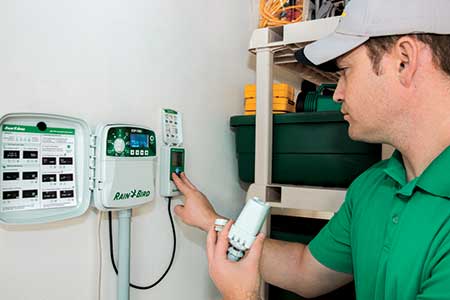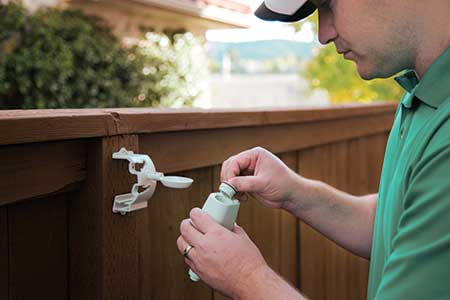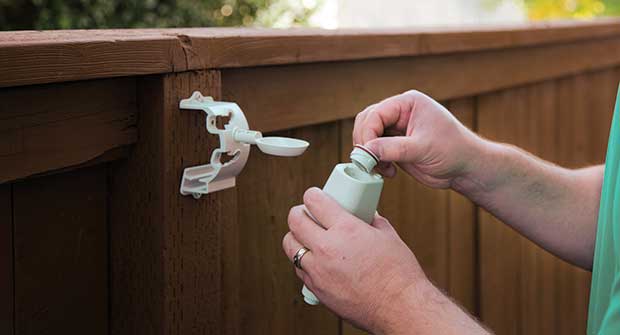
Sensors, at their most basic function, are the on-site eyes and ears of an irrigation system for a contractor, says Doug Callison, water conservation manager for Rain Bird Corp.
The most common sensors for irrigation systems are shut-off devices. These sensors detect whether a certain threshold is met or exceeded in terms of the flow, soil moisture, rain, wind, freeze, pump or evapotranspiration (ET). They can turn off the system if necessary, when connected to an irrigation controller.
Landscape Management talked with Callison and Ben Sacks, associate product manager for Hunter Industries, to learn how irrigation companies can use these sensors to their advantage.
The sense behind sensors
For site monitoring and management, a flow sensor can be extremely helpful, experts say.
“A flow sensor can tell you how much water is being used (or wasted) for irrigation, individual station flow rates and daily, weekly, monthly or annual system flow totals,” Sacks says.
Then, the reading can help a user determine when to close a station valve or master valve on an irrigation system if the flow sensor indicates a higher flow rate than typical.
“Flow sensors are extremely useful for monitoring system flow rates and flow totals,” Sacks says. “Flow sensors are not only informative in reporting how much water is being used but can also prevent landscape damage due to catastrophic high-flow events (mainline breaks, broken laterals, missing sprinkler heads), low flows (pump issues, valves not opening entirely) or unscheduled flows (pinhole leaks in pipes, weeping valves, water flowing when irrigation is not scheduled to run).”
A soil moisture sensor informs users how much moisture is in the root zone, which helps irrigation scheduling. Likewise, a rain, freeze or high-wind sensor can indicate when to avoid irrigation based on weather data.
ET sensors are a robust type of sensor. They measure evapotranspiration, or the loss of water from the earth’s surface from both evaporation and plant transpiration. The ET sensor measures solar radiation, air temperature, relative humidity and wind to calculate evapotranspiration.

“ET sensors are very informative by adjusting irrigation needs based on local climate data,” Sacks says. “Solar radiation, temperature and rainfall measurements can all be used to measure ET and help make controllers ‘smart’ to automatically increase or decrease run times, push watering days out or even cancel scheduled irrigation.”
The area of coverage depends on the type of sensor used, according to Sacks and Callison. For example, rain sensors are popular with residential installations because they are wireless, easy to install and low cost.
“On the commercial side, they are bigger systems, so they tend to use a lot more sensors than on the residential side,” Callison says.
The brains of the operation
Contractors also can monitor sensors via internet-connected irrigation controllers. Users can typically access these cloud-based smart systems anywhere via smartphone, tablet or laptop and receive a notification in the event of a problem. These notifications can help save time, money and conserve resources, Sacks says.
“Let’s say we have a Wi-Fi-enabled controller with a flow sensor monitoring system hydraulics on-site, and there’s a mainline break,” he says. “In this scenario, the flow sensor can detect the unusually high flow rate, autonomously shut down the entire system and send an alert immediately to the user. This lets customers know exactly when issues occur and help to prevent excessive runoff or erosion.”
Sacks also says it’s critical for contractors to understand the features of a smart system to communicate them to a customer after installation.
“Contractors should be able to show the client exactly how to walk through the software and all the features and benefits it can provide,” he says. “The combination of internet-connected control software with a variety of different sensors should give users peace of mind that their irrigation system is operating as efficiently and effectively as it should.”
Know your ordinances
Callison says some states such as Florida and California have local ordinances that mandate sensors to be part of any new commercial irrigation systems, so it’s critical to know what’s necessary for your state or municipality before you install a new irrigation system. For example, Florida requires rain sensors for all controllers, and California is the only state to require a flow sensor.
“In California, new commercial irrigation systems are required to have automatic weather-based adjustments, flow sensors, a master valve, a rain sensor or a method to shut down in real time for rain,” he says. “New residential systems do not need the flow sensor and master valve but still require the automatic weather-based adjustments and a rain shutdown system.”
Often, distributors can advise on any local requirements for sensors, Callison says.
Addressing cost
Costs for sensors can vary in pricing, depending on the model and the type of sensor. For example, flow sensors can cost close to $200 for a residential model, and a commercial-grade sensor can cost around $1,000. A residential rain sensor can range from close to $30, and a higher-end model can be around $100.
Callison adds, “A rain sensor can save a lot of water for a pretty small expense.”
Cost may be a concern to a client who is considering adding sensors to residential projects. A good way to ease some of those concerns is to talk about conserving resources.
“Show the client just how much water or landscape material they can save by using these sensors,” Sacks says.


